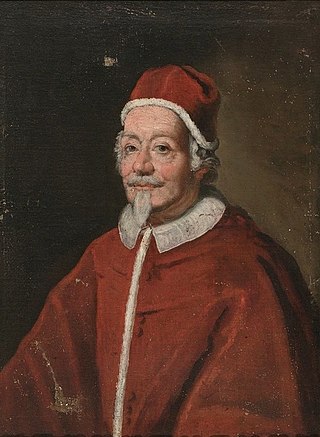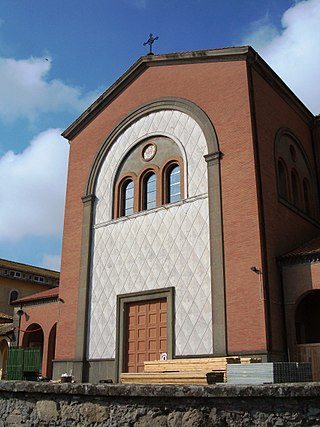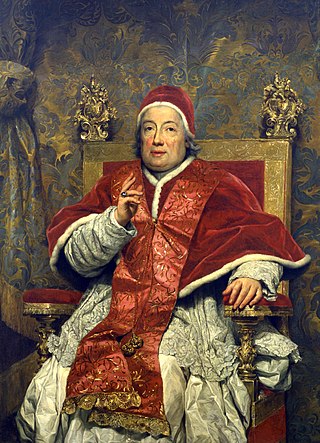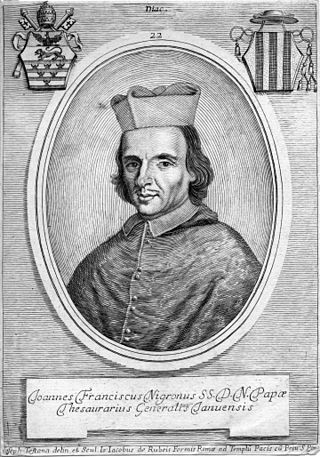
Pope Alexander VIII, born Pietro Vito Ottoboni, was head of the Catholic Church and ruler of the Papal States from 6 October 1689 to his death in February 1691.

Pope Clement XIII, born Carlo della Torre di Rezzonico, was head of the Catholic Church and ruler of the Papal States from 6 July 1758 to his death in February 1769. He was installed on 16 July 1758.

Pope Innocent XII, born Antonio Pignatelli, was head of the Catholic Church and ruler of the Papal States from 12 July 1691 to his death in September 1700.

Pietro Ottoboni was an Italian cardinal and grandnephew of Pope Alexander VIII, who was also born Pietro Ottoboni. He is remembered especially as a great patron of music and art. Ottoboni was the last person to hold the curial office of cardinal-nephew, which was abolished by Alexander's successor, Pope Innocent XII, in 1692. Ottoboni '"loved pomp, prodigality, and sensual pleasure, but was in the same time kind, ready to serve, and charitable."

Giovanni Francesco Barbarigo was an Italian cardinal and nephew of Saint Gregorio Barbarigo (1625–97).

Giambattista Rubini was a cardinal of the Catholic Church from 1690 to 1707.

The Diocese of Bergamo is a Latin diocese of the Catholic Church in Italy, and is a suffragan of the Archdiocese of Milan. Geographically, Bergamo stood between the mainland interests of the Republic of Venice, and the territory of the Duchy of Milan. The duchy was regularly contested by the French and the Holy Roman Empire, which brought about repeated military operations. Internally, from the 12th to the 15th century, there was the usual party strife between the Guelphs, who generally supported the political and religious policies of the Papacy; and the Ghibellines, who generally supported the Emperors. As Kings of Italy, the emperors were feudal overlords of Lombardy.

Decio Azzolino was an Italian Catholic Cardinal, code-breaker, investigator and leader of the Squadrone Volante.

The Diocese of Porto–Santa Rufina is a Latin suburbicarian diocese of the Diocese of Rome and a diocese of the Catholic Church in Italy. It was formed from the union of two dioceses. The diocese of Santa Rufina was also formerly known as Silva Candida.

The 1758 papal conclave, convoked after the death of Pope Benedict XIV, elected Cardinal Carlo Rezzonico of Venice, who took the name Clement XIII.

The 1689 papal conclave was convened after the death of Pope Innocent XI. It led to the election of Cardinal Pietro Vito Ottoboni as Pope Alexander VIII. The conclave saw previous factions join together because they lacked numerical strength, and saw the rise of the zelanti as a political force in the election of the next pope. Ottoboni was eventually unanimously elected with the consent of the secular monarchs, becoming the first Venetian in over 200 years to be elected pope.

The 1691 papal conclave was convened on the death of Pope Alexander VIII and ended with the election of Cardinal Antonio Pignatelli as Pope Innocent XII. It lasted for five months, from 12 February to 12 July 1691. The conclave became deadlocked after Catholic monarchs opposed the election of Gregorio Barbarigo, who some members of the College of Cardinals also viewed as too strict. The conclave only ended in July when cardinals started to become ill from the heat, and after French cardinals agreed to vote for Pignatelli despite him coming from Spanish-controlled Naples.

Pedro Pacheco de Villena, also known as Pedro Pacheco Ladrón de Guevara, was a Spanish cardinal and viceroy of Naples. In Italian his name is spelled Pietro Pacecco. His nephew Francisco Pacheco de Toledo was also a cardinal.

Francesco Gonzaga was an Italian bishop and a Cardinal of the Roman Catholic Church during the reigns of Popes Pius II, Paul II and Sixtus IV.

Pope Alexander VII created thirty eight new cardinals in six consistories:

Bandino Panciatici was a Roman Catholic cardinal from 1690 to 1718.

Giovanni Stefano Donghi was an Italian Catholic cardinal.
Luigi Cornaro was an Italian Roman Catholic cardinal and bishop.

Marcantonio Barbarigo was an Italian cardinal of the Roman Catholic Church. He was the founder of the Pontifical Institute of the Religious Teachers Filippini and also founded both the Religious Teachers Filippini of Montefiascone and the Augustinian Sisters of Divine Love. He was the great-uncle of Pope Clement XIII and was a relative of Gregorio Barbarigo.

Giovanni Francesco Negroni was a Catholic cardinal who served as Bishop of Faenza from 1687 to 1697, and as Legate of Bologna from 1687 to 1690.



















